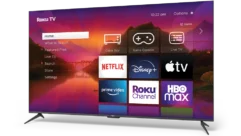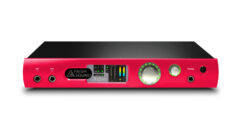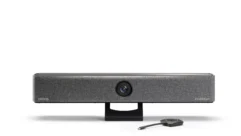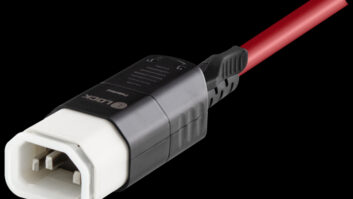
Barco has taken a clean-sheet approach to the design of LCD videowalls with its new UniSee product platform – which the manufacturer believes will revolutionise the videowall experience. Our colleagues atInstallationsaw a pre-production version of UniSee on a visit to the manufacturer earlier this month.
“The biggest pain point with installing and servicing conventional videowalls is detaching them from the mount,” said Suchit Rout, director of global strategic marketing at Barco. The solution? Separate out the electronics from the UniSee View LCM. That way, the LCMs, which weigh just 14kg, are simply docked onto the UniSee Mount after the input boards, power supplies and cabling have been attached. When each panel is installed onto the mount, there is a 3cm gap all around it to facilitate handling and reduce the risk of damage. Think of it as undocking and docking your laptop
Once all the 55in 1920 x 1080 panels have been installed, it’s a matter of using a simple tool to pull the modules together on a ratchet mechanism: first grouping them into columns, then moving the columns horizontally to join them up. A column of up to ten panels can be moved using just one hand. It’s here that the UniSee Mount’s physical design comes into its own: displays can only move up or down at a 45º angle, and so-called ‘smart corners’ enable adjacent screens to self-align as they come together under the force of gravity. The end result is a very narrow gap between panels – approximately 0.3mm, or a couple of pixels.
Accessing a panel for maintenance uses the same process in reverse. The wall is opened up using the same tool until the required panel is accessible – then it’s just a matter of releasing a two clips on the mount to free the panel, the top of which gently swings down. “Think of it as undocking and docking your laptop,” said Rout.
The self-alignment features also compensate for inaccuracies in drilling; according to Barco, holes can be out by as much as 15mm vertically or horizontally. Alignment along the Z-axis can be adjusted by means of a fixing bolt.
Another useful feature is that it is possible to power up a display module and perform a ‘dead on arrival’ test while it is still in the box, without breaking the seal. This offers advantages to the installer, who could save up to a couple of days detecting a damaged panel and ordering a replacement; it also offers advantages to the channel, as damage incurred after the box is opened cannot be passed off as having occurred during shipping. But in any case, the light weight of the panels and the design of the mounting mechanism make on-site damage much less likely.
But it’s not just the mounting and alignment that sets UniSee apart from the competition, according to Barco – it’s the image quality as well. The company is quoting 95% image intra-tile uniformity, significantly outperforming its big-name rivals. Brightness is 800cd/sqm.
The third part of the UniSee platform is the UniSee Connect software, which assigns and calibrates the panels and can be used to manage the entire wall. This uses the same open software platform as all current Barco videowalls. By connecting over IP to the BCM controller on the wall, users can access a user-friendly web-based interface; additionally, an API is available to connect to control systems – either Overture from Barco or other well-known solutions.
UniSee Connect manages Barco’s Sense X automatic calibration system: sensors inside each tile measure colour and brightness in real time, and Sense X immediately makes any adjustments to ensure the image is balanced across the entire wall.
Sense X continues to operate during the lifetime of the wall, which Barco puts at 100,000 hours. Ambient reflections are minimised (the company quotes a 44% haze level), ensuring strong performance in daylight.
Four power supply options are available: built-in single, built-in redundant, remote single and remote redundant. Built-in redundant features two power supplies; automatic failover ensures continuity of power when these are connected to separate power outlets. The remote redundant power supplies are hot-swappable.
Because of its noiseless, fanless operation, Barco says UniSee is suitable for applications that include control rooms, corporate lobbies, boardrooms and meeting rooms.
Rout added that online training and certification programmes for the UniSee platform will be made available on the Barco University web portal.
He concluded: “We’re excited about UniSee. This is the way videowalls should always have been envisioned – and were delighted to be first to bring it to market.”










